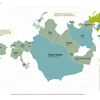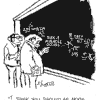11.12.2007 | 00:04
The Financial Tsunami: Sub-Prime Mortgage Debt is but the Tip of the Iceberg
by F. William Engdahl | |||
Global Research, November 23, 2007 | |||
Part 1: Deutsche Bank’s painful lesson Even experienced banker friends tell me that they think the worst of the US banking troubles are over and that things are slowly getting back to normal. What is lacking in their rosy optimism is the realization of the scale of the ongoing deterioration in credit markets globally, centered in the American asset-backed securities market, and especially in the market for CDO’s—Collateralized Debt Obligations and CMO’s—Collateralized Mortgage Obligations. By now every serious reader has heard the term “It’s a crisis in Sub-Prime US home mortgage debt.” What almost no one I know understands is that the Sub-Prime problem is but the tip of a colossal iceberg that is in a slow meltdown. I offer one recent example to illustrate my point that the “Financial Tsunami” is only beginning. Deutsche Bank got a hard shock a few days ago when a judge in the state of Ohio in the USA made a ruling that the bank had no legal right to foreclose on 14 homes whose owners had failed to keep current in their monthly mortgage payments. Now this might sound like small beer for Deutsche Bank, one of the world’s largest banks with over €1.1 trillion (Billionen) in assets worldwide. As Hilmar Kopper used to say, “peanuts.” It’s not at all peanuts, however, for the Anglo-Saxon banking world and its European allies like Deutsche Bank, BNP Paribas, Barclays Bank, HSBC or others. Why? A US Federal Judge, C.A. Boyko in Federal District Court in Cleveland Ohio ruled to dismiss a claim by Deutsche Bank National Trust Company. DB’s US subsidiary was seeking to take possession of 14 homes from Cleveland residents living in them, in order to claim the assets. Here comes the hair in the soup. The Judge asked DB to show documents proving legal title to the 14 homes. DB could not. All DB attorneys could show was a document showing only an “intent to convey the rights in the mortgages.” They could not produce the actual mortgage, the heart of Western property rights since the Magna Charta of not longer. Again why could Deutsche Bank not show the 14 mortgages on the 14 homes? Because they live in the exotic new world of “global securitization”, where banks like DB or Citigroup buy tens of thousands of mortgages from small local lending banks, “bundle” them into Jumbo new securities which then are rated by Moody’s or Standard & Poors or Fitch, and sell them as bonds to pension funds or other banks or private investors who naively believed they were buying bonds rated AAA, the highest, and never realized that their “bundle” of say 1,000 different home mortgages, contained maybe 20% or 200 mortgages rated “sub-prime,” i.e. of dubious credit quality. Indeed the profits being earned in the past seven years by the world’s largest financial players from Goldman Sachs to Morgan Stanley to HSBC, Chase, and yes, Deutsche Bank, were so staggering, few bothered to open the risk models used by the professionals who bundled the mortgages. Certainly not the Big Three rating companies who had a criminal conflict of interest in giving top debt ratings. That changed abruptly last August and since then the major banks have issued one after another report of disastrous “sub-prime” losses. A new unexpected factor The Ohio ruling that dismissed DB’s claim to foreclose and take back the 14 homes for non-payment, is far more than bad luck for the bank of Josef Ackermann. It is an earth-shaking precedent for all banks holding what they had thought were collateral in form of real estate property. How this? Because of the complex structure of asset-backed securities and the widely dispersed ownership of mortgage securities (not actual mortgages but the securities based on same) no one is yet able to identify who precisely holds the physical mortgage document. Oops! A tiny legal detail our Wall Street Rocket Scientist derivatives experts ignored when they were bundling and issuing hundreds of billions of dollars worth of CMO’s in the past six or seven years. As of January 2007 some $6.5 trillion of securitized mortgage debt was outstanding in the United States. That’s a lot by any measure! In the Ohio case Deutsche Bank is acting as “Trustee” for “securitization pools” or groups of disparate investors who may reside anywhere. But the Trustee never got the legal document known as the mortgage. Judge Boyko ordered DB to prove they were the owners of the mortgages or notes and they could not. DB could only argue that the banks had foreclosed on such cases for years without challenge. The Judge then declared that the banks “seem to adopt the attitude that since they have been doing this for so long, unchallenged, this practice equates with legal compliance. Finally put to the test,” the Judge concluded, “their weak legal arguments compel the court to stop them at the gate.” Deutsche Bank has refused comment. What next? As news of this legal precedent spreads across the USA like a California brushfire, hundreds of thousands of struggling homeowners who took the bait in times of historically low interest rates to buy a home with often, no money paid down, and the first 2 years with extremely low interest rate in what are known as “interest only” Adjustable Rate Mortgages (ARMs), now face exploding mortgage monthly payments at just the point the US economy is sinking into severe recession. (I regret the plethora of abbreviations used here but it is the fault of Wall Street bankers not this author). The peak period of the US real estate bubble which began in about 2002 when Alan Greenspan began the most aggressive series of rate cuts in Federal Reserve history was 2005-2006. Greenspan’s intent, as he admitted at the time, was to replace the Dot.com internet stock bubble with a real estate home investment and lending bubble. He argued that was the only way to keep the US economy from deep recession. In retrospect a recession in 2002 would have been far milder and less damaging than what we now face. Of course, Greenspan has since safely retired, written his memoirs and handed the control (and blame) of the mess over to a young ex-Princeton professor, Ben Bernanke. As a Princeton graduate, I can say I would never trust monetary policy for the world’s most powerful central bank in the hands of a Princeton economics professor. Keep them in their ivy-covered towers. Now the last phase of every speculative bubble is the one where the animal juices get the most excited. This has been the case with every major speculative bubble since the Holland Tulip speculation of the 1630’s to the South Sea Bubble of 1720 to the 1929 Wall Street crash. It was true as well with the US 2002-2007 Real Estate bubble. In the last two years of the boom in selling real estate loans, banks were convinced they could resell the mortgage loans to a Wall Street financial house who would bundle it with thousands of good better and worse quality mortgage loans and resell them as Collateralized Mortgage Obligation bonds. In the flush of greed, banks became increasingly reckless of the credit worthiness of the prospective home owners. In many cases they did not even bother to check if the person was employed. Who cares? It will be resold and securitized and the risk of mortgage default was historically low. That was in 2005. The most Sub-prime mortgages written with Adjustable Rate Mortgage contracts were written between 2005-2006, the last and most furious phase of the US bubble. Now a whole new wave of mortgage defaults is about to explode onto the scene beginning January 2008. Between December 2007 and July 1, 2008 more than $690 Billion in mortgages will face an interest rate jump according to the contract terms of the ARMs written two years before. That means market interest rates for those mortgages will explode monthly payments just as recession drives incomes down. Hundreds of thousands of homeowners will be forced to do the last resort of any homeowner: stop monthly mortgage payments. Here is where the Ohio court decision guarantees that the next phase of the US mortgage crisis will assume Tsunami dimension. If the Ohio Deutsche Bank precedent holds in the appeal to the Supreme Court, millions of homes will be in default but the banks prevented from seizing them as collateral assets to resell. Robert Shiller of Yale, the controversial and often correct author of the book, Irrational Exuberance, predicting the 2001-2 Dot.com stock crash, estimates US housing prices could fall as much as 50% in some areas given how home prices have diverged relative to rents. The $690 billion worth of “interest only” ARMs due for interest rate hike between now and July 2008 are by and large not Sub-prime but a little higher quality, but only just. There are a total of $1.4 trillion in “interest only” ARMs according to the US research firm, First American Loan Performance. A recent study calculates that, as these ARMs face staggering higher interest costs in the next 9 months, more than $325 billion of the loans will default leaving 1 million property owners in technical mortgage default. But if banks are unable to reclaim the homes as assets to offset the non-performing mortgages, the US banking system and a chunk of the global banking system faces a financial gridlock that will make events to date truly “peanuts” by comparison. We will discuss the global geo-political implications of this in our next report, The Financial Tsunami: Part 2.
| |||
Um bloggiš
Baldur Fjölnisson
Nżjustu fęrslur
- Torfi Stefįns bannašur ęvilangt
- OL ķ skįk. Landinn malaši Kenķu ķ 9. umferš
- OL ķ skįk: Landinn ķ 88. sęti eftir 8 umferšir
- Mešaljónar ķ skįkinni
- Baggalśtur - Sagan af Jesśsi
- Eitraš fyrir lżšnum?
- Óvenjulega döpur taflmennska innfęddra einkennir Reyjavķkursk...
- U.S. Rushes Coolant to Japanese Nuke Plant After Earthquake
Heimsóknir
Flettingar
- Ķ dag (16.9.): 0
- Sl. sólarhring: 2
- Sl. viku: 7
- Frį upphafi: 0
Annaš
- Innlit ķ dag: 0
- Innlit sl. viku: 6
- Gestir ķ dag: 0
- IP-tölur ķ dag: 0
Uppfęrt į 3 mķn. fresti.
Skżringar
Bloggvinir
-
 Agný
Agný
-
 Alfreð Símonarson
Alfreð Símonarson
-
 Andrea J. Ólafsdóttir
Andrea J. Ólafsdóttir
-
 Bjarni Harðarson
Bjarni Harðarson
-
 Bjarni Kjartansson
Bjarni Kjartansson
-
 Björgvin Gunnarsson
Björgvin Gunnarsson
-
 Brynjar Jóhannsson
Brynjar Jóhannsson
-
 FLÓTTAMAÐURINN
FLÓTTAMAÐURINN
-
 Eygló Þóra Harðardóttir
Eygló Þóra Harðardóttir
-
 FreedomFries
FreedomFries
-
 Fríða Eyland
Fríða Eyland
-
 Félag um stafrænt frelsi á Íslandi
Félag um stafrænt frelsi á Íslandi
-
 Georg P Sveinbjörnsson
Georg P Sveinbjörnsson
-
 Gestur Guðjónsson
Gestur Guðjónsson
-
 Gils N. Eggerz
Gils N. Eggerz
-
 Gullvagninn
Gullvagninn
-
 Gunnar Skúli Ármannsson
Gunnar Skúli Ármannsson
-
 Guðrún María Óskarsdóttir.
Guðrún María Óskarsdóttir.
-
 Gísli Hjálmar
Gísli Hjálmar
-
 Hagbarður
Hagbarður
-
 Halla Rut
Halla Rut
-
 Haraldur Haraldsson
Haraldur Haraldsson
-
 Hilmar Kári Hallbjörnsson
Hilmar Kári Hallbjörnsson
-
 Hlekkur
Hlekkur
-
 Ingibjörg Álfrós Björnsdóttir
Ingibjörg Álfrós Björnsdóttir
-
 Jens Guð
Jens Guð
-
 Jóhannes Ragnarsson
Jóhannes Ragnarsson
-
 Jón Aðalsteinn Jónsson
Jón Aðalsteinn Jónsson
-
 Jón Ragnarsson
Jón Ragnarsson
-
 Jón Steinar Ragnarsson
Jón Steinar Ragnarsson
-
 Jónína Benediktsdóttir
Jónína Benediktsdóttir
-
 Karl Tómasson
Karl Tómasson
-
 Kári Magnússon
Kári Magnússon
-
 Loopman
Loopman
-
 Magnús Þór Hafsteinsson
Magnús Þór Hafsteinsson
-
 Promotor Fidei
Promotor Fidei
-
 Rúnar Sveinbjörnsson
Rúnar Sveinbjörnsson
-
 Salvör Kristjana Gissurardóttir
Salvör Kristjana Gissurardóttir
-
 Sandra María Sigurðardóttir
Sandra María Sigurðardóttir
-
 SeeingRed
SeeingRed
-
 Sigurbjörn Friðriksson
Sigurbjörn Friðriksson
-
 Sigurjón Þórðarson
Sigurjón Þórðarson
-
 Sigurður Þórðarson
Sigurður Þórðarson
-
 Snorri Hrafn Guðmundsson
Snorri Hrafn Guðmundsson
-
 el-Toro
el-Toro
-
 Sveinn Ingi Lýðsson
Sveinn Ingi Lýðsson
-
 Tryggvi Hjaltason
Tryggvi Hjaltason
-
 TómasHa
TómasHa
-
 Túrilla
Túrilla
-
 Upprétti Apinn
Upprétti Apinn
-
 gudni.is
gudni.is
-
 haraldurhar
haraldurhar
-
 proletariat
proletariat
-
 Ívar Pálsson
Ívar Pálsson
-
 Ómar Ragnarsson
Ómar Ragnarsson
-
 Ónefnd
Ónefnd
-
 Óskar
Óskar
-
 Óskar Helgi Helgason
Óskar Helgi Helgason
-
 Óskar Þ. G. Eiríksson
Óskar Þ. G. Eiríksson
-
 Þórir Kjartansson
Þórir Kjartansson
-
 Arnar Guðmundsson
Arnar Guðmundsson
-
 Bara Steini
Bara Steini
-
 Birgir R.
Birgir R.
-
 Birgir Rúnar Sæmundsson
Birgir Rúnar Sæmundsson
-
 brahim
brahim
-
 Brosveitan - Pétur Reynisson
Brosveitan - Pétur Reynisson
-
 Bwahahaha...
Bwahahaha...
-
 Dingli
Dingli
-
 eysi
eysi
-
 Gestur Kristmundsson
Gestur Kristmundsson
-
 Guðbjörg Elín Heiðarsdóttir
Guðbjörg Elín Heiðarsdóttir
-
 Gunnar Helgi Eysteinsson
Gunnar Helgi Eysteinsson
-
 Gunnar Rögnvaldsson
Gunnar Rögnvaldsson
-
 Helgi Jóhann Hauksson
Helgi Jóhann Hauksson
-
 Hlini Melsteð Jóngeirsson
Hlini Melsteð Jóngeirsson
-
 Jakobína Ingunn Ólafsdóttir
Jakobína Ingunn Ólafsdóttir
-
 Katrín Snæhólm Baldursdóttir
Katrín Snæhólm Baldursdóttir
-
 kreppukallinn
kreppukallinn
-
 Kristín Magdalena Ágústsdóttir
Kristín Magdalena Ágústsdóttir
-
 Máni Ragnar Svansson
Máni Ragnar Svansson
-
 Morgunblaðið
Morgunblaðið
-
 Neo
Neo
-
 Orgar
Orgar
-
 Ragnar L Benediktsson
Ragnar L Benediktsson
-
 Rauði Oktober
Rauði Oktober
-
 Skákfélagið Goðinn
Skákfélagið Goðinn
-
 Sveinn Þór Hrafnsson
Sveinn Þór Hrafnsson
-
 Vilhjálmur Árnason
Vilhjálmur Árnason
-
 Þór Ludwig Stiefel TORA
Þór Ludwig Stiefel TORA




Bęta viš athugasemd [Innskrįning]
Ekki er lengur hęgt aš skrifa athugasemdir viš fęrsluna, žar sem tķmamörk į athugasemdir eru lišin.